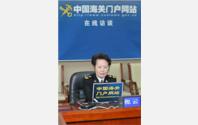 Online Interview
Online Interview
Topic: The Past & the Present of China Customs – about a Close Look into China Customs Museum
Time:10:00 AM (Thu) March 27, 2014
Special Guests: Ni Yun, Curator of China Customs Museum
The Past & the Present of China Customs – about a Close Look into China Customs Museum
[Ni Yun]: China Customs Museum houses a number of relatively important collections, or the so-called “iconic treasures”. For example, an eaves tile with the Chinese character “guan” in seal script from the Han Dynasty, a mailbag used by Robert Hart from more modern times, the only extant copy of the Map of Coastal Lighthouses in China, China’s first postage stamp—Dragon Stamp, a wooden tablet inscribed with Chinese characters “Jin Hai Xin Guan (New Jinhai Customs)” written by Li Hongzhang, as well as much nearer the Letter of Appointment for the first Minster of General Administration of Customs of the People’s Republic of China signed by Chairman Mao Zedong and the “Customs 902” Vessel that witnessed the important speeches addressed by Deng Xiaoping during his South China Tour. 03/27/2014 10:11:30
[Wang Hua]: Wow, you are very familiar with these collections! I believe many online friends want to hear about the stories behind these treasures. Ms. Ni, would you please tell us some stories? 03/27/2014 10:12:13
[Ni Yun]: OK. I’d like to start with the eaves tile with the Chinese character “guan” in seal script. It is obtained from an open collection in the society. So far, the eaves tile with the Chinese character “guan” has been unearthed in Xin’an County, Henan Province only. It is an architectural component of the gatehouses of Hangu Pass built in Han Dynasty. Hangu Pass at that time was the first pass in the city of Luoyang, the starting point of the Silk Road, and it has some connection with the origin of Customs. Here’s an interesting story—Laozi went out of Hangu Pass. Though many people have heard about this anecdote, they probably do not know that this Hangu Pass was in effect the earliest form of customs, and Ying Xi, in this story was the first customs official recorded in China’s historical literature. His position, Pass Governor, is equivalent to Director General of Customs nowadays. 03/27/2014 10:13:10
[Wang Hua]: Could it be said that Laozi has something to do with customs? Could you tell something more specific about this story? 03/27/2014 10:13:54
[Ni Yun]: Of course. The story goes like this: according to historical records, one day in late Spring and Autumn Period, Ying Xi, the Governor of Hangu Pass, was patrolling on the gate tower when he suddenly saw a purple cloud rising above from the east. He reckoned that a sage would pass by, and thus ordered the officers and soldiers watching the pass to pay attention. By twilight, Ying Xi saw an old man approaching slowly riding a black ox. 03/27/2014 10:14:47
[Ni Yun]: The old man, with a red face, big ears and long beard, looked like an immortal. It turned out that the old man was Laozi. Once as an official in charge of historical records for the Zhou court, Laozi couldn’t stand the corruption and inefficiency of the official circle, thus resigned and planned to live a reclusive life. Seeing Laozi, Ying Xi immediately went out of the Pass to welcome Laozi on his knees and passionately persuaded him to stay. During his stay at Hangu Pass, Laozi had the luxury of peace to write down his thoughts, and completed the ageless classic Tao Te Ching. During this process, Ying Xi was deeply impressed by the profundity and broadness of Laozi’s thoughts. Thus he respected Laozi as his teacher and resigned from his post, finally followed and accompanied Laozi to lead a reclusive life. 03/27/2014 10:15:55
[Wang Hua]: Upon hearing this story, I realize that customs office, to my surprise, is a witness to the writing of Tao Te Ching by Laozi. Speaking of Hangu Pass, I remember the portrayal or mentioning of such passes in some verses from ancient poems, such as “The spring breeze never blows beyond the Jade Pass”, and “West of Yangguan Pass there'll be no old friends”. The functions of such passes are similar to those of the current customs offices, right? 03/27/2014 10:16:43
[Ni Yun]: Yes. The early passes were all inland customs, including Hangu Pass, Yanmen Pass, Jade Pass, Jiayu Pass and Juyong Pass. These inland border passes played important roles in foreign trade and cultural exchanges between China and other countries. It was only later that coastal customs offices were set up. 03/27/2014 10:17:23
[Wang Hua]: The Map of Coastal Lighthouses, and the wooden tablet with inscription “Jin Hai Xin Guan” written by Li Hongzhang you’ve mentioned earlier are antiquities related to coastal Customs. Are there also lesser-known stories behind these cultural relics? 03/27/2014 10:18:04
[Ni Yun]: The Map of Chinese Coastal Lighthouses collected in the China Customs Museum is the only extant copy in China. Previously, we knew that it’s the only copy extant in China’s Mainland. Until last year, during a tour by a group of domestic and foreign experts specializing in customs history, an expert from Taiwan Province told us that there was no copy of this map seen in Taiwan. Therefore, it can be said that this copy is the only one extant. 03/27/2014 10:18:33
Quick Links







